Pradhan Mantri Awas Yojana: Affordable, safe housing is not just a shelter — it’s a foundation for better living, health, education and opportunity. Recognising this, the Government of India launched the Pradhan Mantri Awas Yojana (PMAY) — a bold initiative to provide “Housing for All” by a target year. Through this mission, millions of families across urban and rural areas are being helped to move into pucca houses with essential amenities.

Pradhan Mantri Awas Yojana (PMAY) 2025 – Overview Table
| Scheme Name | Pradhan Mantri Awas Yojana (PMAY) |
|---|---|
| Launched By | Government of India |
| Launch Date | 25 June 2015 |
| Implemented By | Ministry of Housing and Urban Affairs (MoHUA) & Ministry of Rural Development (MoRD) |
| Scheme Type | Central Government Housing Scheme |
| Main Objective | To provide affordable housing for all eligible urban and rural families |
| Tagline / Mission | “Housing for All” |
| Target Beneficiaries | Economically Weaker Sections (EWS), Low Income Groups (LIG), Middle Income Groups (MIG), Slum Dwellers, and Rural Poor |
| Scheme Components | 1. PMAY–Urban (PMAY-U) 2. PMAY–Gramin (PMAY-G) |
| Financial Assistance | Up to ₹2.67 lakh subsidy (under CLSS) depending on income group and home loan |
| Ownership Mandate | Female ownership or co-ownership required for EWS/LIG categories |
| Loan Subsidy Scheme | Credit Linked Subsidy Scheme (CLSS) for home loans |
| Types of Construction | New House Construction, Home Upgradation, or Purchase of Ready House |
| Application Mode | Online & Offline |
| Official Website (Urban) | https://pmaymis.gov.in/ |
| Official Website (Rural) | https://pmayg.nic.in/ |
| Eligibility Criteria | Applicant must not own a pucca house in any part of India and must fall within eligible income group |
| Assistance Under PMAY (Urban) | ₹1.5–2.67 lakh (depending on income category and loan amount) |
| Assistance Under PMAY (Gramin) | ₹1.2 lakh (plain areas) and ₹1.3 lakh (hilly/IAP regions) |
| Target Year (Urban) | Extended beyond 2022 for completion of pending houses |
| Monitoring System | PMAY MIS Portal (for Urban) & AwaasSoft (for Rural) |
| Latest Updates | Focus on completing pending houses and promoting eco-friendly, disaster-resilient construction under PMAY 2.0 |
| Helpline Number | 1800-11-3377 / 1800-11-6163 |
| Official Email | support-pmay@gov.in (for urban queries) |
What is PMAY?
Pradhan Mantri Awas Yojana (PMAY) is a flagship housing scheme of the Government of India. It has two major verticals:
- PMAY-Urban (PMAY-U): Aims to address the housing shortage in urban areas including for Economically Weaker Sections (EWS), Low Income Groups (LIG) and Middle Income Groups (MIG) by providing assistance for house construction/up-gradation.
- PMAY-Gramin (PMAY-G): Focuses on rural areas, guiding and supporting rural households without permanent homes, to get safe and durable housing.
Launched initially on 25 June 2015, the urban vertical targeted to complete the “Housing for All” mission in urban areas by 2022.
Key Objectives
- Ensure that every eligible urban household has access to a pucca house with basic amenities like sanitation, water supply, electricity and access.
- Prioritise vulnerable groups: especially the EWS/LIG segments, slum-dwellers, women (female head/co-owner), SC/ST households, differently-abled and other needy segments.
- Promote environmentally sustainable and disaster-resilient housing technologies.
- Enable affordable housing through credit subsidies (especially for MIG households) and facilitate partnerships with private and public agencies.
Major Features & Benefits
- Central assistance: Under PMAY-U, the central government grants funds to states/UTs or implementing agencies to cover part cost of house construction, upgradation, or subsidy on home loans.
- Inclusivity of women: A mandatory provision ensures that the female head of the household (or in her absence a female member) is either owner or co-owner of the house.
- Multiple implementation routes: For the urban component:
- In-Situ Slum Redevelopment (ISSR) using land as resource
- Affordable Housing in Partnership (AHP)
- Beneficiary Lead Construction/Enhancement (BLC/BLCE)
- Credit-Linked Subsidy Scheme (CLSS) for eligible beneficiaries
- Eco-friendly & tech-led construction: Through initiatives such as the Global Housing Technology Challenge – India (GHTC-India), the scheme emphasises fast-track, innovative, disaster-resilient housing construction.
- Urban migration & rental housing focus: To address needs of migrants and informal workers in cities, the scheme also includes Affordable Rental Housing Complexes (ARHCs) under PMAY-U.
- Monitoring & transparency: A dedicated MIS portal tracks progress; beneficiaries can check status online; portals like the CLSS Awas Portal (CLAP) integrate all stakeholders.
Who is eligible?
While specific criteria vary by state/UT and rural vs urban verticals, core eligibility features generally include:
- Households without a pucca house in their name in urban or rural areas (as applicable).
- Priority to EWS/LIG households (in urban areas) and rural households from identified categories.
- For home-loan subsidy (CLSS), income limits apply.
- Applicants must not own any other house/flat under the benefit area (as per scheme guidelines).
- Female ownership/co-ownership is required (especially in the EWS/LIG urban verticals).
How to Apply for PMAY (Urban)
Here’s a general step-by-step process for the urban scheme — exact steps may differ slightly by city or state:
- Visit the official portal of PMAY-U or the local municipal/city housing authority.
- Check for the “Apply Online” or “Beneficiary Search” section (for example the portal at PMAY MIS). PMAY-HFA
- Fill in the assessment/applicant form: personal details, family details, income details, location, whether house exists etc.
- Upload required documents: identity proof, income certificate, Aadhaar, photographs, land/plot proof (if applicable) etc.
- The implementing agency (state/UT/slum redevelopment authority/municipal corporation) verifies the details, validates demand and processes sanction.
- For CLSS applicants applying via banks for home-loan subsidy: apply through eligible lending institution; subsidy is credited to the loan account.
- Regularly track status online using the portal’s “Track Your Assessment Status” or similarly named function.
- Upon sanction & completion, house construction/upgradation begins; central assistance is released to implementing agency or beneficiary as per guidelines.
How to Apply for PMAY (Gramin)
For the rural vertical:
- Applications are submitted via the local Gram Panchayat / block / state rural housing agency.
- Beneficiaries fill in the required form, submit documents, get selected based on priority need, house is constructed as per technical specifications, and completion certificate is issued.
- Funds are released in stages from Central Government → State → Project implementing agency → beneficiary.
Progress & Impact
As of recent reports, the urban scheme has sanctioned millions of houses across India, committed large central investment, and shown considerable progress in grounded and completed houses. (For latest numbers, check the MIS portal.) PMAY-HFA
The rural scheme likewise has achieved large scale coverage in many states, significantly improving housing conditions for rural poor.
Why Does PMAY Matter?
- Social upliftment: Owning a safe house provides security, dignity, and opportunity for better health and education outcomes.
- Urban transformation & slum upgrading: In urban areas, providing proper housing to slum-dwellers and low income families is key to sustainable urban growth.
- Economic stimulus: Housing construction generates jobs (in construction, materials, allied services), stimulating local economies.
- Women’s empowerment: The co-ownership clause ensures women become part of the asset creation process.
- Environmental & resilience aspects: With newer construction technologies and resilience norms, homes under PMAY are being built to last, with lower maintenance burdens.
Things to Keep in Mind / Tips for Applicants
- Ensure you apply via the correct portal / implementing agency for your city or village and vertical (Urban vs Gramin).
- Keep all documents ready before applying (identity, address, income, family composition).
- If applying under CLSS, ensure you approach an eligible lending institution and verify their participation.
- Monitor status online regularly; follow up with the local implementing agency if required.
- In states/UTs where scheme covers up‐gradation of existing houses, check conditions and incentives before proceeding.
- Government portals update numbers periodically; always refer to official portal for latest progress, guidelines and forms.
Challenges & Considerations
- While targets were set for 2022 in the urban vertical, actual completion on ground may vary by region; stakeholders need persistent monitoring.
- Land availability in dense urban locations remains a challenge for house construction or slum upgrading.
- Quality of construction and timely completion remain critical to sustain trust in the scheme.
- Awareness at beneficiary level is still uneven — hence local outreach and easy-to-use applications are vital.
| Apply Online | click here |
Conclusion
The Pradhan Mantri Awas Yojana stands as one of India’s most ambitious efforts to achieve housing for all. Whether urban or rural, its aim is to ensure that every eligible citizen has access to a safe, durable home with dignity. If you qualify, it is worth exploring your eligibility, applying early and leveraging your state/UT’s entire support ecosystem. A home isn’t just four walls — it’s the launching pad for a brighter future.


